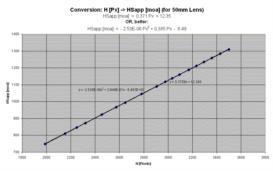
NavList:
A Community Devoted to the Preservation and Practice of Celestial Navigation and Other Methods of Traditional Wayfinding
Re: Camera distortion of sky images. was Re: NG's "Midnight Fun
From: George Huxtable
Date: 2010 Jun 15, 21:38 +0100
From: George Huxtable
Date: 2010 Jun 15, 21:38 +0100
Greg Rudzinski wrote- "It is my understanding that the modern digital 50mm SLR camera produces an image equivalent to a 75 or 80mm film version." He added- "Also the diagonal is probably not a good way to measure with sensors arrayed in a rectangular grid.". Well, assuming radial symmetry of the distortion about the frame centre, the measurement could be made just as well across a central axis, lengthways or heightways, as across a diagonal. My intention in checking on the diagonal was to explore distortion over the whole area, right into the corners, where the distortions are likely to be greatest. and- "No clamping of the camera is needed with shutter speeds over 1/500 of a second. At these shutter speeds camera shake is not a factor and will allow use on a small craft. Sun limbs are surprisingly sharp even with a hand held telephoto. See attached 200mm example." That Sun disc in Greg's attachment was very sharp, showing what a steady hand he has. But that wasn't the purpose of the clamping that I proposed. The intention was to fix the camera over the whole sequence of observations, just as in the Greenland example we've been looking at. Presumably Greg's picture was taken from on land. I suggest that observing from the unsteady footing of a small craft would be a very different matter, even at 1/500 sec. =========================== If we take a mid-value of 78 mm, between Greg's suggested equivalent of "75 or 80mm", that would subtend angles about the centre point of +/13.0º about the width of the frame, +/- 8.7º about the height, and +/- 15.5º to the corners. This is significantly narrower than the angular width of the Greenland photo we have been looking at, so the distortions will be considerably less. The "50mm" graph supplied by Marcel, and attached again here, showed altitudes amounting to nearly 22º, equally disposed about the centre, so that the horizon must be 11º below the centre and the Sun 11º above it, that must have been made with the camera in "portrait" mode. That's what Greg was referring to in "rotating the camera 90 degrees". Marcel provided calibration plots for both 50mm and 100mm lenses, but the one of real interest is that of 50mm, which is attached once again. Those graphs show remarkably careful observation, with very little scatter about the fitted line, and don't depart much from simple linearity. But depart they do, as shown by the computed line of fit not passing through the origin, but showing a small offset. Two alternative fitted equations are shown, one linear, one second-order, with little to choose between them, but it looks to me as though only one line-of-fit has been drawn, the second-order fit. I have used that graph to check out my suggested model, in which radius in the array varies as the tan of the subtended angle from the centre point. In this case, because each measurement has been equally disposed about that centre point (a sensible practice which minimises distortion) the relevant angle is half the altitude. So I have tried a function as follows- H(pixels) = 18140 Tan (altitude / 2) (in degrees) or, for those that prefer it the other way, Altitude in degrees = 2 arc-tan ( pixels / 18140) And I can report that that function fits exactly on top of the data and the fit-line that's already drawn in, so that it's just not possible to see any difference. And if, as is likely but unconfirmed, the array has been made with exactly the same spacing along the other axis, that will be the calibration curve on that direction also. And, indeed, along a radius in every other direction too, if such a radius is measured in pixel-equivalents using Pythagoras.. The constant of 18140, which depends on the pixel spacing (which we haven't been told) and the focal length, was arbitrarily chosen to get a fit. Of course, it's a poor test of the correctness of the tangent model, simply because it's restricted to such a small range of angles from the optic axis, so the resulting distortion is so low. All we can really say is that it doesn't discredit that model by showing any disagreement with observation. However, from that model, I can now confidently predict that at the maximum altitude shown. of 22º, the distortion will enhance the observed diameter of the Sun, in the vertical direction, by 3%, over what it would have been if seen on the optic axis. And enhance its width by 1%. So if Sun diameter is being used as a yardstick for calibration, that would have to be taken into account. George. contact George Huxtable, at george@hux.me.uk or at +44 1865 820222 (from UK, 01865 820222) or at 1 Sandy Lane, Southmoor, Abingdon, Oxon OX13 5HX, UK.







